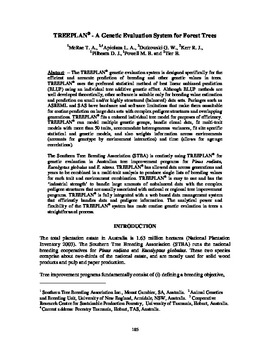| dc.contributor.author | McRae, T. A. | |
| dc.contributor.author | Apiolaza, L. A. | |
| dc.contributor.author | Dutkowski, G. W. | |
| dc.contributor.author | Kerr, R. J. | |
| dc.contributor.author | Pilbeam, D. J. | |
| dc.contributor.author | Powell, M. B. | |
| dc.contributor.author | Tier, B. | |
| dc.date.accessioned | 2016-04-25T19:36:00Z | |
| dc.date.available | 2016-04-25T19:36:00Z | |
| dc.date.issued | 2003 | |
| dc.identifier | oksd_sf27_p105.pdf | |
| dc.identifier.citation | McRae, T. A., Apiolaza, L. A., Dutkowski, G. W., Kerr, R. J., Pilbeam, D. J., Powell, M. B., & Tier, B. (2003). "TREEPLAN� - A Genetic Evaluation System for Forest Trees." In 27th Southern Forest Tree Improvement Conference, Stillwater, OK | |
| dc.identifier.uri | https://hdl.handle.net/11244/33674 | |
| dc.description.abstract | The TREEPLAN� genetic evaluation system is designed specifically for the efficient and accurate prediction of breeding and other genetic values in trees. TREEPLAN� uses the preferred statistical method of best linear unbiased prediction (BLUP) using an individual tree additive genetic effect. Although BLUP methods are well developed theoretically, other software is suitable only for breeding value estimation and prediction on small and/or highly structured (balanced) data sets. Packages such as ASREML and SAS have hardware and software limitations that make them unsuitable for routine prediction on large data sets with complex pedigree structures and overlapping generations. TREEPLAN� fits a reduced individual tree model for purposes of efficiency. TREEPLAN� can model multiple genetic groups, handle clonal data, fit multi-trait models with more than 50 traits, accommodate heterogeneous variances, fit site specific statistical and genetic models, and also weights information across environments (accounts for genotype by environment interaction) and time (allows for age:age correlations). The Southern Tree Breeding Association (STBA) is routinely using TREEPLAN� for genetic evaluation in Australian tree improvement programs for Pinus radiata, Eucalyptus globulus and E. nitens. TREEPLAN� has allowed data across generations and years to be combined in a multi-trait analysis to produce single lists of breeding values for each trait and environment combination. TREEPLAN� is easy to use and has the �industrial strength� to handle large amounts of unbalanced data with the complex pedigree structures that are usually associated with national or regional tree improvement programs. TREEPLAN� is fully integrated with a web based data management system that efficiently handles data and pedigree information. The analytical power and flexibility of the TREEPLAN� system has made routine genetic evaluation in trees a straightforward process. | |
| dc.format | application/pdf | |
| dc.language | en_US | |
| dc.relation.ispartofseries | Sponsored publication . . . of the Southern Forest Tree Improvement Committee ; no. 49 | |
| dc.rights | This paper is made available through open access and the auspices of the fair use doctrine for scholarly, educational and research purposes while recognizing the publisher already offers a free online version. The OSU Library�s intent is to offer access and preserve publications involving its faculty contributions. Contact the Digital Resources and Discovery Services at lib-dls@okstate.edu or 405-744-9161 for the permission policy on the use, reproduction or distribution of this material. | |
| dc.source | Proceedings of the 27th Southern Forest Tree Improvement Conference, volume 27, 2003. Editor, Craig R. McKinley. | |
| dc.title | TREEPLAN� - A Genetic Evaluation System for Forest Trees | |
| dc.type | text | |
| osu.filename | oksd_sf27_p105.pdf | |
| dc.type.genre | Conference proceedings | |
| dc.description.scopeandcontents | Papers and abstracts from the 27th Southern Forest Tree Improvement Conference held at Oklahoma State University in Stillwater, Oklahoma on June 24-27, 2003. | |
